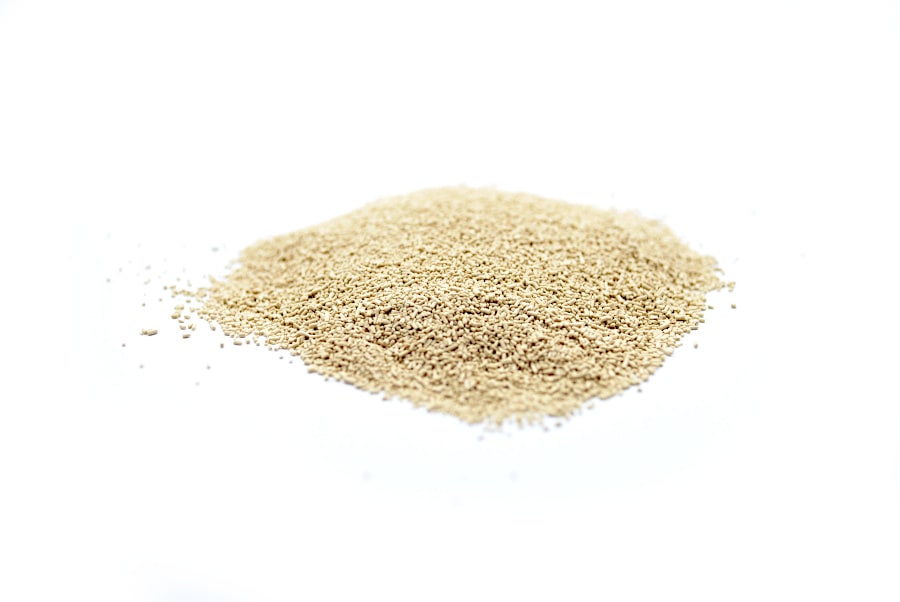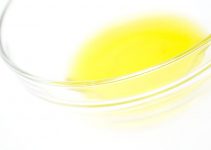When it comes to the debate active dry yeast vs instant yeast, are we going to discover any notable differences between these two types of yeast or are they actually interchangeable?
Are there instances where active dry yeast should be used instead of instant yeast?
These are the main questions that we’re going to answer in this debate. Let’s get right down to answering these important questions and then we’ll move on to analyzing these two types more in-depth.
Contents
Active Dry Yeast vs Instant Yeast: Interchangeable 1:1
If you’ve read any of the following books: Bread Baking for Beginners by Bonnie Ohara or Flour Water Salt Yeast Ken Forkish, you’ll discover that these two writers and bakers actually recommend using instant yeast.
Moreover, they both state that they use the SAF Red Instant Yeast. It works for breads and pizzas. It is indeed one of the best types of yeast to use, whatever you’re baking.
Even if the recipe calls for active dry yeast, you can still use the SAF Red Instant Yeast, without changing the quantity.
As I’ve said, the main thing to take away from an active dry yeast vs instant yeast debate is that they’re interchangeable on a 1:1 basis.
Recipes will state the kind of yeast that should be used
When it comes to dry yeast, there are 2 main options: active dry yeast and instant yeast.
But, as I’ve said, you can use the one from SAF even if the recipes calls for ADY.
There’s actually a third options when it comes to what recipes call for: the instance where you’re told to use 1 package of active dry yeast. In that case, you should be aware that 1 packet of yeast contains 7 grams of yeast.
If you’re using SAF, those 7 grams are the equivalent of 1-3/4 teaspoons.
If you’re using active dry yeast, like the one from Red Star, which is excellent, those 7 grams are the equivalent of 2-1/2 teaspoons.
That doesn’t mean that there aren’t differences between these two types of dry yeast. But they aren’t that important. Even so, let’s see what we should know. It’s a nice curiosity to satisfy.
Along the ride, you’re actually going to discover that these two dry yeast types have more in common than otherwise. There are a couple small differences between them. But that doesn’t impact dough rising that much.
Which means that they can be substituted for one another 1:1, without modifying the quantity by a granule.
Types of Yeast: Dry & Fresh

If we’re going technical, there are actually 5 types of yeast:
- active dry yeast
- instant dried yeast (fast-acting) – what we call simply instant yeast
- quick-rise yeast – pretty much the same as instant yeast only called by a different name
- compressed fresh cake yeast – what we call fresh yeast
- bread machine yeast – if you’re going to check out my yeast for bread machine post, I actually mentioned that you don’t need to use the special bread machine yeast because it’s more expensive, you should definitely use normal active dry yeast or instant yeast, depending on what the recipe calls for
In the end, we’re actually left with two main types of yeast:
- dry yeast – which can be further split into active and instant (they’re both the granulated kind)
- fresh yeast (cake yeast) – can be used instead of active dry but you need a yeast conversion table and it needs precise liquid temperatures of 90°F – 95°F, that’s the most important thing to keep in mind, it can be added directly to dry ingredients without prior softening in warm water
Active Dry Yeast vs Instant Yeast: What They Do
The word yeast actually means to rise, it comes from the French word levant.
The role of any type of yeast, whether we’re talking about active dry, instant or fresh yeast, is to make the dough rise.
When we’re making desserts, we’re using baking powder or baking soda.
Yeast is the ingredient that makes the dough double in size. The double in size thing is still the main guideline many of us are following when we’re letting the dough go through the bulk fermentation and proofing (the two rise phases).
In order to achieve that, yeast consumes carbohydrates (sugar and starches) and expels carbon dioxide
Simply put, that’s what makes the dough rise until it’s proofed enough and it’s ready for scoring and baking.
The Differences Between ADY and Instant Yeast
Instant yeast doesn’t need to be dissolved in liquid, it’s added directly to the rest of the ingredients, whether you’re using your own hands to mix and knead the ingredients or you’re using a stand mixer or a bread machine as a dough kneader.
The fast-acting part is what actually defines instant dried yeast. And that’s where the main difference lies in when it comes to our instant yeast vs active dry yeast debate.
Instant yeast has a higher concentration of yeast cells, which makes the dough rise more quickly.
Active dry yeast makes the dough rise slower.
Active dry yeast is the common yeast, it still remains the most popular of all and the most widely used. It’s what most recipes call for.
This is the type we dissolve in warm water for about 10 minutes and then proceed to mixing all the ingredients together.
However, you can actually skip the dissolving step and the recipe won’t be ruined. If you knead the dough properly and let it rise through both phases as it should, your loaf will be perfectly risen.
The difference is much more noticeable between the two when it comes to bread machines.
Instant yeast is especially used under the bake rapid/quick/express cycles. This is pretty much the only area where you can’t use active dry instead of instant.
What Active Dry Yeast and Instant Yeast Have in Common
First, we’ve already established that they both belong to the larger category of dry yeasts.
And their role is to make the dough rise.
They’re both granular yeasts. Both also have a granulated composition, the granules for the instant yeast are a bit smaller but they still look pretty similar.
Can You Substitute Active Dry Yeast for Instant Yeast?
Yes, they’re both interchangeable. The same principle applies when talking about all purpose flour vs bread flour.
And you can actually substitute them on a 1:1 basis. Meaning, you don’t have to modify the quantity of active dry yeast or the quantity of instant yeast.
Since I mentioned that active dry yeast is the slower of the two, you should just add 15-20 minutes to the rising time if you’re using active dry instead of instant yeast.
You can subtract the same amount of time if you’re using instant instead of active dry.
The time the dough needs to rest and rise differs. It’s a process influenced by a number of factors, room temperature being one of the most obvious ones.
It’s best to judge by yourself if the dough has risen enough and it’s ready for baking. There’s no actual set time by the minute.
What is really important to remember is the fact that it’s perfectly fine to substitute active dry yeast for instant yeast and vice versa. As you’re going to see in a minute, my first recommendation and the favorite yeast for many bakers is actually the instant yeast from SAF.
The 1:1 substitution has one exception: when using a bread machine.
If you’re using a bread machine to knead and rise the dough, it’s best to use 25% less instant yeast if you’re substituting it for active dry yeast.
But you can experiment with using the same amount in your first substitution experiment and see how that goes.
Best Yeast for Bread & Pizza
Now that we’ve established what active dry yeast and instant yeast are used for and what makes them different but at the same time quite closely related since they’re both dry yeasts, it’s time to actually see which is the best yeast for bread.
1. SAF Instant Yeast – Best Dry Yeast for Bread & Baked Goods
I’m pretty sure that you’re surprised that the first best yeast for bread that I’m recommending is the instant yeast type instead of going for the active dry yeast, since I said that it’s the most popular yeast type.
However,
The SAF Instant Yeast is not just any type of yeast. It’s the best yeast for bread for a number of reasons, a favorite for both professional and household bakers.
Why is that?
Because it’s a powerful yeast with a high concentration of yeast cells, which can be used to make everything from breads to cakes.
If you’re using a stand mixer or kneading dough by hand, you can use the SAF Instant Yeast in the same quantity that the recipes states, there’s no problem using the same amount of SAF even if the recipes calls for active dry yeast.
When it comes to using a bread machine to make the dough or the bread, you can add 25% less SAF for the recipes calling for active dry. Or you can use the same amount and see how that goes. I would say that both options are good.
The SAF Instant Yeast is also pretty cheap, an all-round pretty perfect baking product that deserves a place in any kitchen.
They also make the SAF Gold Instant Yeast, which is recommended for sweet breads but it’s not necessary to buy a separate pack, I just though I should mention it.
2. Red Star Active Dry Yeast
If you want the get the best active dry yeast, the Red Star is the one to opt for.
The price is excellent, it’s quite affordable and the quality is one of the best.
It does come in a big quantity so, you should definitely freeze a large part of it and you can keep it in the freezer, in an airtight container for up to a year.
There’s really not much to say, this is just one of the best active dry yeasts on the market.
3. Fleichmann’s Instant Yeast
If you have a problem finding the SAF Instant Yeast and you want another good option for instant yeast, there’s Fleichmann’s Instant Yeast.
It also has a good price.
From the same manufacturer, there’s also the Fleichmann’s Yeast for Bread Machine, in case you’re looking for a yeast that bears the yeast for bread machine label. I don’t think it’s necessary, you can use regular yeast since the price is a bit high for those labeled as yeast for bread machine.
How to Store Dry Yeast
Most of us buy our yeast in bulk because that’s how it’s usually sold. So, we definitely need to pay attention to storing dry yeast properly in order to be able to use it for very long periods of time.
Thankfully, storing dry yeast is very easy and it doesn’t involve a lot of preparation.
Unopened packages can be stored in a cool dry place – cupboard, pantry. Once opened, an airtight container is the best storage tool for yeast.
You can place the airtight container in the freezer for up to 1 year. Using a freezer bag for freezing yeast works just as well.
The yeast can be used directly from the freezer. The other option is to let it sit at room temperature for half an hour. Either way works.
Yeast can be refrigerated for up to 4-6 months.
How to Test Yeast for Viability
If you’ve had your yeast for quite a while, whether the active dry or the instant type, there’s a quick viability test to see if the yeast is still capable of its rising capability.
Fill a cup with lukewarm water, add 1 tablespoon yeast and 1 teaspoon sugar. Mix them together. If the yeast is active, it will bubble immediately. If there are only a few bubbles, you need to get yourself some new yeast.
Active Dry Yeast vs. Instant Yeast FAQs
Let’s quickly condenses what we’ve learn from our active dry yeast vs instant yeast debate by answering a few pertinent questions.
1. Can you substitute instant yeast for ADY?
You can and with ease. It’s especially true if you’re using the SAF Instant Yeast, which is the most popular both among professional and amateur bakers. The advantage is that instant yeast doesn’t need to be dissolved in warm water. It can be mixed in and kneaded directly.
2. Which is better active dry yeast or instant yeast?
They’re both very good and they both can be used interchangeably. The main difference is that instant yeast has a higher concentration of yeast cells, which makes it fast-acting. The dough can rise more quickly. Moreover, instant yeast is not dissolved. It can be argued that ADY doesn’t need to be dissolved in warm water, either. Although, people continue doing it.
3. What if I used active dry yeast instead of instant?
Nothing will happen, except the dough might need a bit more time until it completes both its fermentation and proofing stages. You can add 15-20 minutes to the rising time. However, to be on the safe side, I recommend testing if the fermentation and proofing are complete. For fermentation, stick two fingers in the dough to the second knuckle, the indentations should still remain. For proofing, touch the side of the dough with your fingertip, just enough to make a small indentation, if the indentation remains, it’s ready for baking.
Well, that’s about everything you need to know when it comes to an active dry yeast vs instant yeast debate, as you saw there wasn’t much to debate, since they’re pretty similar types of dry yeast that can be used interchangeably.




